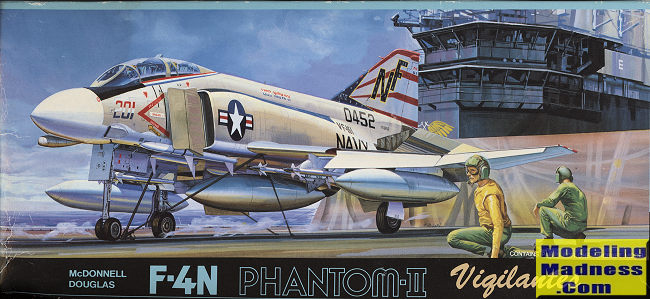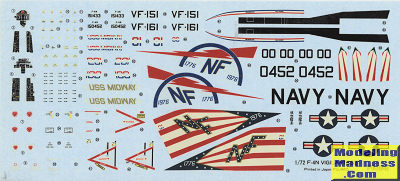
Fujimi 1/72 F-4N Phantom II 'Vigilantes'
|
KIT # |
G-3 |
|
PRICE: |
$10.00 'used' |
|
DECALS: |
Two options |
|
REVIEW : |
|
|
NOTES: |
1986 release |

|
HISTORY |
The F-4B was the second major Phantom variant in the Navy's inventory and, as happens to all airframes, it was getting rather tired. Rather than spend the extra money to build entire new aircraft, it was decided to upgrade the F-4B. This was accomplished under project Bee Line and the modification was done on 228 airframes at NARF San Diego starting in early 1972.
The following changes were made to the F-4B: Structural strengthening, complete rewiring, ASW-25 data link, improved IR seeker, a helmet sight, air to air IFF equipment (APX-76 and KIT-1A/KIR-1A), a dogfight computer, engine smoke abatement equipment, Mode C IFF(Altitude Reporting), and finally, upgraded ECM equipment. Most of the changes to the aircraft were internal, though one can tell an F-4N from an F-4B by the addition of ECM antennas on the intake trunking. The N model retains the thinner high pressure tires and no upper wing bulges of the earlier F-4B. A number of surviving F-4Ns were converted to QF-4N drones. There are currently no USN-type F-4s flying.
|
THE KIT |
Upon
opening the box, one is confronted with a mass of parts that are now quite
familiar to F-4 builders, but was then rather novel. There are three polybags
full of medium grey F-4 bits. All of the parts are superbly detailed and have
nicely engraved panel lines. There are all the proper pylons and weapons to do
the proper version kitted. There are also various inserts, something relatively
new to modeling at the time, to enable the modeler to build the specific type.
Typical of these kinds of kits, there are also a few things that have to be cut
off as well, but nothing that any semi-competent modeler could not do.
Where
this kit lags current Phantom kits and even later boxings by Fujimi are in the
cockpit and canopy. The early releases only offer a closed canopy option. Also
the interiors are not really that good. They are rather generic in design and
the same regardless of if you have a Navy or Air Force version. Instrument
panels and side consoles are decals, which was fine for the day, a
characteristic that many modern 1/72 kit makers continue. There is also no sidewall detail whatsoever, again,
something that we expect from mainstream kits today. As a note to builders, the
first twelve boxings of their Phantom series had major gaps behind the cockpit
section that was fixed in later kits by supplying a bulkhead/blanking plate.
This kit does not have that. Considering how basic the cockpit is, I'm surprised
that no one has ever done a resin replacement for this kit. At least, I've never
heard of one. Instructions are quite good offering all
sorts of closeup images to assist in building. Color information is given in the
construction sequence with paint numbers corresponding to the Gunze Sangyo line
of paints. No FS numbers are give Probably the first really good F-4 kits in 1/72 are these that were
produced by Fujimi in 1985. At last modelers no longer had to make do with the
rather dodgy Airfix, Revell and old Hasegawa kits. While Monogram did downsize
their F-4C and F-4J kits about this same time, Fujimi offered an entire line of
Phantoms, including the 'flat winged' Navy F-4B and F-4N.
Probably the first really good F-4 kits in 1/72 are these that were
produced by Fujimi in 1985. At last modelers no longer had to make do with the
rather dodgy Airfix, Revell and old Hasegawa kits. While Monogram did downsize
their F-4C and F-4J kits about this same time, Fujimi offered an entire line of
Phantoms, including the 'flat winged' Navy F-4B and F-4N. n. The instructions themselves are in both
Japanese and English. Markings are for both of what were the USS Midway fighter
squadrons in the 70s and 80's. The box art plane was with VF-151 and the other
set of markings is for VF-161. Both are in light gull grey over white and are
bicentennial markings. The VF-161 option will require the black fuselage stripe
and canopy surround to be painted. Midway unit markings were a staple of
Japanese USN kits for many years as they were 'local' and so sold well. The decals do offer everything one needs in terms of general markings.
Like other Japanese kit decals, they are a bit think and the builder must
use very warm to hot water to soak them in so as to get optimum performance from
them. These are also over 30 years old so one uses them at one's risk. There are
LOTS of aftermarket options.
n. The instructions themselves are in both
Japanese and English. Markings are for both of what were the USS Midway fighter
squadrons in the 70s and 80's. The box art plane was with VF-151 and the other
set of markings is for VF-161. Both are in light gull grey over white and are
bicentennial markings. The VF-161 option will require the black fuselage stripe
and canopy surround to be painted. Midway unit markings were a staple of
Japanese USN kits for many years as they were 'local' and so sold well. The decals do offer everything one needs in terms of general markings.
Like other Japanese kit decals, they are a bit think and the builder must
use very warm to hot water to soak them in so as to get optimum performance from
them. These are also over 30 years old so one uses them at one's risk. There are
LOTS of aftermarket options.
|
CONCLUSIONS |
Other
than the cockpit, the Fujimi Phantoms are quite presentable and build into very
nice models. I have built a large number of them and cannot see any reason not
to do so in the future. Though no longer being produced, they can still be found
for a fairly decent price. .
REFERENCES McDonnell Douglas Aircraft since 1920: Volume II, by Rene
J Francillon, 1990, Naval Institute Press January 2021 Copyright ModelingMadness.com. All rights reserved. Review kit courtesy of me and my wallet! If you would like your product reviewed fairly and quickly by a
site that has over 1,700 visits a day, please contact
me or see other details in the Note to
Contributors.